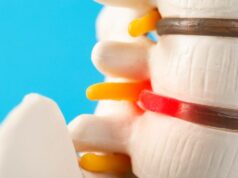
Stayble Therapeutics shifts focus to phase Ib study in disc herniation
Following dissapointing results from the phase IIb study, Stayble Therapeutics is shifting its focus to the phase Ib study in hearniated disc patients. At the same time, the company plans to reduce costs in order to complete the study without additional funding. CEO Andreas Gerward shares more details in an interview with BioStock.
Stayble Therapeutics’ drug candidate STA363 is an injection treatment for back pain. The candidate is based on lactic acid, an endogenous substance that induces a connective tissue transformation after injection.
Since 2020, Stayble Therapeutics has conducted a clinical phase IIb study with STA363 to evaluate the efficacy of the treatment on patients with degenerative disc disease (DDD). In early 2023, the company also initiated a phase Ib study with STA363 in patients with chronic disc herniation (LDH).
Focus on herniated discs
The company recently announced that the phase IIb study did not reach the primary goal of showing a statistically significant reduction in pain after six months compared to placebo.
Following this setback, the company now chooses to shift its focus to the phase Ib study in disc herniation. In August, the first patient was included in the study and the goal is to recruit a total of 24 patients.
The study is randomized, double-blinded and placebo-controlled and will evaluate the safety and tolerability of the STA363 treatment. In addition, disc volume, bone pain, and disc intensity will be measured as secondary endpoints. The company hopes that their experience in clinical trials will benefit the implementation of the study.
Same candidate – two mechanisms
According to the company, STA363 has two different mechanisms for reducing the patient’s pain in the two indications. In degenerative disc disease, the goal was to achieve pain reduction by creating a stiffness in the disc and reducing inflammation, while the herniated disc treatment is based on reducing disc volume and hernia, thereby alleviating the pain.
Preliminary analyses of the phase IIb study support the company’s theory. The height of the discs in the patients decreased, which is a sign of reduced disc volume. According to the company, this change is crucial to achieve the pain-relieving effect in herniated disc patients.
Reduces costs
According to the Q3 report, the company’s cash amounted to 21,3 MSEK at the end of September. Furthermore, they report an operating loss of -17.5 MSEK for the first nine months of the year. Stayble is now reviewing how to drastically reduce costs in order to have sufficient financial endurance to carry out the phase I study in herniated discs.
In order to save on expenses, the size of the organisation and external costs are reviewed. The company has chosen to pause the agreement with transaction advisor Ferghana Partners, which was supposed to provide support in partnering activities.
CEO comments on the setback and the way forward

BioStock reached out to the company’s CEO Andreas Gerward to find out more about how they plan to move forward after the setback in the phase IIb study.
What is your strategy to find new motivation and look forward after such a setback as the phase IIb results actually were?
– Driving drug development is incredibly exciting but also involves high risk. Even though you can never prepare for negative data, the scenario has always been there. We are proud of a well-executed study that delivered high-quality data even in difficult times during the pandemic and the invasion of Ukraine. We are now looking forward to our study on herniated discs, where we bring valuable experiences as well as data from the phase IIb study.
What lessons are you taking from the phase IIb study into the development of treatments for herniated discs?
– We bring a detailed understanding of patient recruitment, changes in disc height and intensity, as well as experiences from conducting studies during challenging times. We are well-versed in conducting clinical development and familiar with many of the challenges along the way.
Could you tell us a bit more about the treatment mechanism and the data that reinforces your belief that the potential for the herniated disc project still remains?
– In degenerative disc disease, the aim is to achieve pain reduction by creating stiffness in the disc and reducing inflammation, while the treatment for herniated discs focuses on reducing the volume of the disc and the herniation to alleviate pain.
– Preliminary analyses of the phase IIb study show a relevant decrease in disc height, which can translate into a volume change in treated discs. This confirms earlier assumptions that STA363 induces a volume change, which forms the basis of our herniated disc treatment project.
Why is another phase I study required when you have already shown that STA363 is safe?
– Although the innovations are similar, they are two different indications and patient groups. To then go directly into a larger phase IIb study without phase Ib data is considered to be very difficult from a regulatory point of view.
What is the timeline for the phase Ib study involving patients with herniated discs?
– Right now, patient recruitment is in full swing, and we anticipate completing the recruitment by Q1, as previously communicated.
You plan to reduce costs in order to complete the phase Ib study. What does your cost-saving plan entail?
– Cost-saving measures involve reducing the company’s structure and reducing all external expenses. Stayble operates as a virtual company, allowing us to swiftly cut costs and prioritise development expenses.
Finally, what can we expect from Stayble Therapeutics in the upcoming months?
– We will continue analysing the phase IIb data in detail and will return to the market with a more comprehensive presentation. This applies to both DDD but also insights from the LDH project. Concurrently, we will advance our herniated disc study with the current focus on patient recruitment. The study progresses as planned, and we look forward to sharing more about the study and the path forward.
The content of BioStock’s news and analyses is independent but the work of BioStock is to a certain degree financed by life science companies. The above article concerns a company from which BioStock has received financing.

